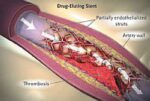Original title: Impact of hemodialysis on local vessel healing and thrombus formation after drug-eluting stent implantation. Reference: Akihide Konishi, et al. Journal of Cardiology 2014;64:25-31 Even though the benefit of DES implantation to the general population is undeniable, it has been proved lower in hemodialysis patients (HD); the reason behind this phenomenon remains unclear. 121 patients received<a href="https://solaci.org/en/2014/08/08/hemodialysis-associated-to-higher-incidence-of-in-stent-thrombosis/" title="Read more" >...</a>
Thrombosis with bioresorbable scaffolds: the story of DES all over again?
Original title: Percutaneous coronary intervention with everolimus-eluting bioresorbable vascular scaffolds in routine clinical practice: early and midterm outcomes from the European multicentre GHOST-EU registry. Reference: Capodanno D et al. EuroIntervention. 2014 Jul 18. Epub ahead of print The GHOST-EU registry, that included 1189 patients from 10 European centers between 2011 and 2014, is now the largest registry<a href="https://solaci.org/en/2014/07/30/thrombosis-with-bioresorbable-scaffolds-the-story-of-des-all-over-again/" title="Read more" >...</a>
Reduced risk of acute, late and very late thrombosis with new generations of DES versus BMS in the acute myocardial context
Original title: Stent thrombosis in new-generation drug-eluting stents in patients with STEMI undergoing primary PCI: a report from SCAAR. Reference: Sarno G et al. J Am Coll Cardiol. 2014;Epub ahead of print. This study evaluated 34147 consecutive patients suffering acute myocardial infarction with ST-segment elevation included in the SCAAR registry (Swedish Coronary Angiography and Angioplasty Registry) undergoing primary<a href="https://solaci.org/en/2014/07/11/reduced-risk-of-acute-late-and-very-late-thrombosis-with-new-generations-of-des-versus-bms-in-the-acute-myocardial-context/" title="Read more" >...</a>
Ticagrelor reduces in-stent thrombosis in patients with acute coronary syndromes
Original title: Stent thrombosis with ticagrelor versus clopidogrel in patients with acute coronary syndromes: An analysis from the prospective randomized PLATO trial. Reference: Steg PG et al. Circulation. 2013; Epub ahead of print The PLATO study randomized 18624 patients with acute coronary syndrome to receive ticagrelor (180 mg loading dose followed by 90 mg twice daily )<a href="https://solaci.org/en/2013/09/12/ticagrelor-reduces-in-stent-thrombosis-in-patients-with-acute-coronary-syndromes/" title="Read more" >...</a>
Rivaroxaban reduces in-stent thrombosis in patients with acute coronary syndromes
Original title: Reduction of Stent Thrombosis in Patients With Acute Coronary Syndromes Treated With Rivaroxaban in ATLAS-ACS 2 TIMI 51. Reference: C. Michael Gibson et al. J Am Coll Cardiol 2013;62:286–90. There are few contemporary studies that investigated oral anticoagulation utility in patients with acute coronary syndromes and coronary angioplasty. Rivaroxaban is an oral anticoagulant that directly and<a href="https://solaci.org/en/2013/08/23/rivaroxaban-reduces-in-stent-thrombosis-in-patients-with-acute-coronary-syndromes/" title="Read more" >...</a>
Double DES in bifurcations, double thrombosis risk
Original title: Late Thrombosis After Double Versus Single Drug-Eluting Stent in the Treatment of Coronary Bifurcations A Meta-analysis of Randomized and Observational Studies. Reference: Marco Zimarino et al. J Am Coll Cardiol Intv 2013. Article in press. In the era of drug-eluting stents, (DES), several randomized and observational studies have been conducted trying to find the best strategy<a href="https://solaci.org/en/2013/06/14/double-des-in-bifurcations-double-thrombosis-risk/" title="Read more" >...</a>
Stent Thrombosis in the Real World
Original title: Incidence and predictors of stent trombosis: a single-centre study of 5833 consecutive patients undergoing coronary artery stenting Reference: Javaid Iqbal et al. EuroInterventional 2013;9:62-69 Though potentially fatal, stent thrombosis is a low frequency event associated to stent malapposition, fractures, resistance to antiplatelet therapies, and diseases such as diabetes and kidney disease, among other factors. 5883 pacients<a href="https://solaci.org/en/2013/05/31/stent-thrombosis-in-the-real-world/" title="Read more" >...</a>
Future strategies to prevent restenosis and stent thrombosis
Original title: Endothelial cell repopulation after stenting determines in-stent neointima formation: effects of bare-metal vs. drug-eluting stents and genetic endothelial cell modification. Reference: Douglas G et al. European Heart Journal doi:10.1093/eurheartj/ehs240 Experimental models of vascular injury have shown that the rate of endothelial cell repopulation post-injury is a critical factor in determining subsequent neointima formation as well as<a href="https://solaci.org/en/2012/12/04/future-strategies-to-prevent-restenosis-and-stent-thrombosis/" title="Read more" >...</a>
Risk score of thrombosis in patients with acute coronary syndrome
Original title: Development and Validation of a Stent Thrombosis Risk Score in Patients With Acute Coronary Syndromes. Reference: George D. Dangas et al. J Am Coll Cardiol Intv 2012;5:1097–105. The implantation of a stent in a pro thrombotic condition such as acute coronary syndrome (ACS) is associated with a higher incidence of stent thrombosis. There is no data<a href="https://solaci.org/en/2012/11/23/risk-score-of-thrombosis-in-patients-with-acute-coronary-syndrome/" title="Read more" >...</a>
Initial Complete Revascularization vs. Staged Revascularization in Patients with STEMI and Multivessel Disease
In patients with ST-segment elevation acute myocardial infarction (STEMI) undergoing primary percutaneous coronary intervention (primary PCI), multivessel disease is observed in up to 40% of cases. The optimal timing for revascularizing non-culprit lesions in these patients without cardiogenic shock remains a controversial issue. European guidelines recommend completing revascularization during the initial procedure or within 45 days<a href="https://solaci.org/en/2024/07/17/initial-complete-revascularization-vs-staged-revascularization-in-patients-with-stemi-and-multivessel-disease/" title="Read more" >...</a>








